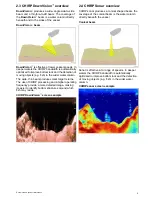
receive a weaker GPS signal. GPS antenna mounted
below decks will be more susceptible to performance
issues related to the prevailing conditions.
Compass safe distance
To prevent potential interference with the vessel's
magnetic compasses, ensure an adequate distance
is maintained from the display.
When choosing a suitable location for the display
you should aim to maintain the maximum possible
distance between the display and any compasses.
Typically this distance should be at least 1 m (3 ft)
in all directions. However for some smaller vessels
it may not be possible to locate the display this far
away from a compass. In this situation, the following
figures provide the minimum safe distance that
should be maintained between the display and any
compasses.
D
12650-1
2
00 m
m
(7.8
7 in)
350
mm
(13.8
in)
70
0 m
m
(27
.5
in)
50
0 m
m
(19
.7
in)
2
50 m
m
(9.8
4 in)
00
0
1
2
3
3
00 m
m
(11.8
in)
4
5
6
Item
Compass
position in
relation to
display
Minimum safe
distance from
display
1
Top
200 mm (7.87 in.)
2
Rear
500 mm (19.7 in.)
3
Right-hand side
350 mm (13.8 in.)
4
Underside
300 mm (11.8 in.)
5
Front
700 mm (27.5 in.)
6
Left-hand side
250 mm (9.84 in.)
Viewing angle considerations
As display contrast and color are affected by the
viewing angle, If you intend to surface mount the
display, it is recommended that you temporarily
power up the display when planning the installation,
to enable you to identify which location gives the
optimum viewing angle.
Wi-Fi location requirements
A number of factors can influence Wi-Fi
performance, it is important to ensure you test the
Wi-Fi performance, at the desired location before
installing Wi-Fi enabled products.
Distance and signal strength
The distance between Wi-Fi products should always
be kept to a minimum. Do not exceed the maximum
stated range of your Wi-Fi product (Maximum range
will vary for each device).
Wi-Fi performance degrades over distance so
products farther away will receive less network
bandwidth. Products installed close to their
maximum Wi-Fi range may experience slow
connection speeds, signal drop outs or not being
able to connect at all.
Line of sight and obstacles
For best results the Wi-Fi product should have a
clear, direct line of sight to the product it will be
connected to. Any physical obstructions can degrade
or even block the Wi-Fi signal.
The construction of your vessel can also have an
impact on Wi-Fi performance. For example, metal
structural bulkheads and roofing will reduce and in
certain situations, block the Wi-Fi signal.
If the Wi-Fi signal passes through a bulkhead
containing power cables this can also degrade Wi-Fi
performance.
Reflective surfaces such as metal surfaces, some
types of glass and even mirrors can drastically effect
performance or even block the Wi-Fi signal.
interference and other equipment
Wi-Fi products should be installed at least 1m (3 ft)
away from:
• other Wi-Fi enabled products
• transmitting products that send wireless signals in
the same frequency range
• other electrical, electronic or electromagnetic
equipment that may generate interference
Interference from other peoples Wi-Fi products can
also cause interference with your products. You can
use a Wi-Fi analyzer tool to assess the best Wi-Fi
channel (channel not in use or used by least amount
of devices) for you to use.
Product dimensions – Dragonfly–4 and
Dragonfly–5
145 mm (5.7 in.)
1
4
5
m
m
(
5
.7
in
.)
56 mm (2.2 in.)
90 mm (3.5 in.)
120 mm (4.7 in.) min.
D13181-1
Care points:
• For variants with built-in GPS, install in a location
where the GPS performance will not be affected
by vessel structure; test GPS performance before
installation.
• Allow a minimum of 120 mm (4.7 in.) behind the
display for inserting and removing a MicroSD card.
Planning the installation
27






































![Humminbird ] 981 Installation & Operation Manual preview](http://thumbs.mh-extra.com/thumbs/humminbird/981/981_installation-and-operation-manual_2183846-01.webp)
